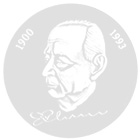Fundamental contributions to room- and psychoacoustics, and the invention of linear predictive coding and codebook exited coding of speech
Research in Speech Coding, Concert Hall Acoustics and Number Theory – an impressive field of work
Mobile phones have become such a common part of our daily life that we do not any more realize how complex and numerous the technical solutions are to make them work. Over the last decade the mobile phone has developed from a rather cumbersome instrument to a compact, lightweight toy. The well designed outside has made us ignorant of the immense complexity of the necessary algorithms and components inside. To make a mobile phone call possible, our speech is processed through different stages to eventually reach the receiver s ear in almost original quality. The most important step and dominating factor in determining the speech quality is the data reduction realized by so called “Codecs” (derived from coding, decoding). Without this data reduction to approximately only one tenth, phone of many people simultaneously would be impossible!
The invention of the “linear predictive coding LPC” by Prof. Schroeder and Bishnu Atal in 1967 and their invention of the “codebook exited linear prediction CELP” ist the most important fundament for today`s speech compression algorithms. Many improvements of this technology have eventually resulted in the quality and stability of todays speech codecs, as already implemented in more than a billion mobile phones.
Speech quality in itself or more generally the quality of any acoustical signal is, of course, a very subjective matter that is difficult to measure. His problem has been addressed by the research of Prof. Schroeder in many different ways. For example, he managed, together with a team of physicists, to reproduce the original sound of 22 major concert halls with such precision that a world first a direct acoustical comparison was possible without the need for time-consuming, worldwide travel! The results had a major impact on the design of concert halls. It turned out that modern concert halls, which are mostly wide and have low ceilings, are the worst design one could imagine in terms of good acoustics. In contrast many older halls are much more optimal and have better acoustics. In the context of this research a very sophisticated wall structure was invented, the “Schroeder-Reflectors”, which not only has an attractive appearance but also improves the sound of a concert hall considerably.
The Schroeder-reflectors are one example of applying methods of number theory to acoustival problems probably the first time with such a practical impact! This was an approach that led to many ideas and proposals of considerable relevance, even to the latest communication systems. For example, Prof. Schroeder pursued his “hobby” of generating low-peak-factor-signals for quite a while. This is, in simple terms, the problem of generating many tones simultaneously (with given amplitudes of each tone) but keeping the maximum amplitude at a minimum. Surely an interesting exercise if you try to solve this while playing a huge accord on a grand piano! Today the lowpeak- factor is a key problem in some of the most advanced communication technologies: surfing on the internet at high speed often uses the ADSL standard. This method transmits data on several “tones” (i.e. carriers) simultaneously but has to squeeze the mixture of all these tones through cable, amplifiers and all the connected equipment hence requiring a low peak amplitude.
These examples just illustrate the enormous bandwidth of Prof. Schroeder`s research. His work has influenced many different research areas and has led to important results. Prof. Manfred Robert Schroeder is being honoured with the Eduard Rhein Award for his scientific work an for the invention of linear predictive coding.
Dr. Sönke Mehrgardt,
SODANA CONSULTING, Deisenhofen
